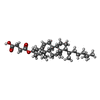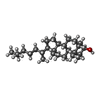[English] 日本語
 Yorodumi
Yorodumi- PDB-9mfl: Structure of zebrafish OTOP1 in nanodisc in the presence of inhib... -
+ Open data
Open data
- Basic information
Basic information
| Entry | Database: PDB / ID: 9mfl | ||||||
|---|---|---|---|---|---|---|---|
| Title | Structure of zebrafish OTOP1 in nanodisc in the presence of inhibitor C11 | ||||||
 Components Components | Proton channel OTOP1 | ||||||
 Keywords Keywords | MEMBRANE PROTEIN / proton channel / ion channel / OTOP / Otopetrin | ||||||
| Function / homology |  Function and homology information Function and homology informationotolith formation / otolith mineralization / proton channel activity / inner ear morphogenesis / cholesterol binding / negative regulation of type II interferon-mediated signaling pathway / microvillus / proton transmembrane transport / cellular response to insulin stimulus / identical protein binding ...otolith formation / otolith mineralization / proton channel activity / inner ear morphogenesis / cholesterol binding / negative regulation of type II interferon-mediated signaling pathway / microvillus / proton transmembrane transport / cellular response to insulin stimulus / identical protein binding / membrane / plasma membrane Similarity search - Function | ||||||
| Biological species |  | ||||||
| Method | ELECTRON MICROSCOPY / single particle reconstruction / cryo EM / Resolution: 3.73 Å | ||||||
 Authors Authors | Burendei, B. / Ward, A.B. | ||||||
| Funding support |  United States, 1items United States, 1items
| ||||||
 Citation Citation |  Journal: Nat Commun / Year: 2025 Journal: Nat Commun / Year: 2025Title: Structure-guided discovery of Otopetrin 1 inhibitors reveals druggable binding sites at the intrasubunit interface. Authors: Batuujin Burendei / Joshua P Kaplan / Gerardo M Orellana / Emily R Liman / Stefano Forli / Andrew B Ward /  Abstract: Proton conductance across cell membranes serves many biological functions, ranging from the regulation of intracellular and extracellular pH to the generation of electrical signals that lead to ...Proton conductance across cell membranes serves many biological functions, ranging from the regulation of intracellular and extracellular pH to the generation of electrical signals that lead to sour taste perception. Otopetrins (OTOPs) are a conserved, eukaryotic family of proton-selective ion channels, one of which (OTOP1) serves as a gustatory sensor for sour tastes and ammonium chloride. As the functional properties and structures of OTOP channels were only recently described, there are presently few tools available to modulate their activity. Here, we perform subsequent rounds of molecular docking-based virtual screening against the structure of zebrafish OTOP1, followed by functional testing using whole-cell patch-clamp electrophysiology, and identify several small molecule inhibitors that are effective in the low-to-mid µM range. Cryo-electron microscopy structures reveal inhibitor binding sites in the intrasubunit interface that are validated by functional testing of mutant channels. Our findings reveal pockets that can be targeted for small molecule discovery to develop modulators for Otopetrins. Such modulators can serve as useful toolkit molecules for future investigations of structure-function relationships or physiological roles of Otopetrins. | ||||||
| History |
|
- Structure visualization
Structure visualization
| Structure viewer | Molecule:  Molmil Molmil Jmol/JSmol Jmol/JSmol |
|---|
- Downloads & links
Downloads & links
- Download
Download
| PDBx/mmCIF format |  9mfl.cif.gz 9mfl.cif.gz | 144.2 KB | Display |  PDBx/mmCIF format PDBx/mmCIF format |
|---|---|---|---|---|
| PDB format |  pdb9mfl.ent.gz pdb9mfl.ent.gz | 109.7 KB | Display |  PDB format PDB format |
| PDBx/mmJSON format |  9mfl.json.gz 9mfl.json.gz | Tree view |  PDBx/mmJSON format PDBx/mmJSON format | |
| Others |  Other downloads Other downloads |
-Validation report
| Summary document |  9mfl_validation.pdf.gz 9mfl_validation.pdf.gz | 1.6 MB | Display |  wwPDB validaton report wwPDB validaton report |
|---|---|---|---|---|
| Full document |  9mfl_full_validation.pdf.gz 9mfl_full_validation.pdf.gz | 1.6 MB | Display | |
| Data in XML |  9mfl_validation.xml.gz 9mfl_validation.xml.gz | 38.9 KB | Display | |
| Data in CIF |  9mfl_validation.cif.gz 9mfl_validation.cif.gz | 53.8 KB | Display | |
| Arichive directory |  https://data.pdbj.org/pub/pdb/validation_reports/mf/9mfl https://data.pdbj.org/pub/pdb/validation_reports/mf/9mfl ftp://data.pdbj.org/pub/pdb/validation_reports/mf/9mfl ftp://data.pdbj.org/pub/pdb/validation_reports/mf/9mfl | HTTPS FTP |
-Related structure data
| Related structure data |  48234MC  9mffC  9mfmC C: citing same article ( M: map data used to model this data |
|---|---|
| Similar structure data | Similarity search - Function & homology  F&H Search F&H Search |
- Links
Links
- Assembly
Assembly
| Deposited unit | 
|
|---|---|
| 1 |
|
- Components
Components
| #1: Protein | Mass: 65817.000 Da / Num. of mol.: 2 Source method: isolated from a genetically manipulated source Details: first two residues (GP) are leftover residues from a 3C protease cleavage site. 3rd residue (V) corresponds to the 2nd residue of the zebrafish OTOP1 sequence (Uniprot:Q7ZWK8) Source: (gene. exp.)   Homo sapiens (human) / References: UniProt: Q7ZWK8 Homo sapiens (human) / References: UniProt: Q7ZWK8#2: Chemical | ChemComp-Y01 / #3: Chemical | ChemComp-QNJ / ( Has ligand of interest | N | Has protein modification | N | |
|---|
-Experimental details
-Experiment
| Experiment | Method: ELECTRON MICROSCOPY |
|---|---|
| EM experiment | Aggregation state: PARTICLE / 3D reconstruction method: single particle reconstruction |
- Sample preparation
Sample preparation
| Component | Name: zebrafish OTOP1 in MSP2N2 nanodisc / Type: COMPLEX / Entity ID: #1 / Source: RECOMBINANT | ||||||||||||||||||||
|---|---|---|---|---|---|---|---|---|---|---|---|---|---|---|---|---|---|---|---|---|---|
| Molecular weight | Value: 0.131 MDa / Experimental value: NO | ||||||||||||||||||||
| Source (natural) | Organism:  | ||||||||||||||||||||
| Source (recombinant) | Organism:  Homo sapiens (human) / Cell: HEK293F / Plasmid: pEG Homo sapiens (human) / Cell: HEK293F / Plasmid: pEG | ||||||||||||||||||||
| Buffer solution | pH: 8 | ||||||||||||||||||||
| Buffer component |
| ||||||||||||||||||||
| Specimen | Conc.: 2 mg/ml / Embedding applied: NO / Shadowing applied: NO / Staining applied: NO / Vitrification applied: YES Details: sample was complexed with small molecule C11, reaching a final concentration of 1.11mM, and 1% DMSO | ||||||||||||||||||||
| Specimen support | Grid material: GOLD / Grid mesh size: 300 divisions/in. / Grid type: UltrAuFoil R1.2/1.3 | ||||||||||||||||||||
| Vitrification | Instrument: FEI VITROBOT MARK IV / Cryogen name: ETHANE / Humidity: 100 % / Chamber temperature: 283.15 K |
- Electron microscopy imaging
Electron microscopy imaging
| Experimental equipment |  Model: Talos Arctica / Image courtesy: FEI Company |
|---|---|
| Microscopy | Model: FEI TALOS ARCTICA |
| Electron gun | Electron source:  FIELD EMISSION GUN / Accelerating voltage: 200 kV / Illumination mode: FLOOD BEAM FIELD EMISSION GUN / Accelerating voltage: 200 kV / Illumination mode: FLOOD BEAM |
| Electron lens | Mode: BRIGHT FIELD / Nominal magnification: 36000 X / Nominal defocus max: 1800 nm / Nominal defocus min: 800 nm / Cs: 2.7 mm / C2 aperture diameter: 70 µm / Alignment procedure: COMA FREE |
| Specimen holder | Cryogen: NITROGEN / Specimen holder model: OTHER |
| Image recording | Average exposure time: 9.8 sec. / Electron dose: 50.37 e/Å2 / Detector mode: COUNTING / Film or detector model: GATAN K2 SUMMIT (4k x 4k) / Num. of grids imaged: 1 / Num. of real images: 3552 Details: Forty-nine frames of 200 ms exposure time were collected per movie |
| Image scans | Width: 3710 / Height: 3838 / Movie frames/image: 49 |
- Processing
Processing
| EM software |
| ||||||||||||||||||||||||||||||||||||||||||||||||||||||||||||
|---|---|---|---|---|---|---|---|---|---|---|---|---|---|---|---|---|---|---|---|---|---|---|---|---|---|---|---|---|---|---|---|---|---|---|---|---|---|---|---|---|---|---|---|---|---|---|---|---|---|---|---|---|---|---|---|---|---|---|---|---|---|
| Image processing | Details: Micrographs with CTF estimates (Gctf) worse than 5A were discarded. | ||||||||||||||||||||||||||||||||||||||||||||||||||||||||||||
| CTF correction | Type: PHASE FLIPPING AND AMPLITUDE CORRECTION | ||||||||||||||||||||||||||||||||||||||||||||||||||||||||||||
| Particle selection | Num. of particles selected: 3410686 | ||||||||||||||||||||||||||||||||||||||||||||||||||||||||||||
| Symmetry | Point symmetry: C2 (2 fold cyclic) | ||||||||||||||||||||||||||||||||||||||||||||||||||||||||||||
| 3D reconstruction | Resolution: 3.73 Å / Resolution method: FSC 0.143 CUT-OFF / Num. of particles: 164766 Details: final reported resolution of 3.73A was obtained through the Remote 3DFSC Processing server Num. of class averages: 2 / Symmetry type: POINT | ||||||||||||||||||||||||||||||||||||||||||||||||||||||||||||
| Atomic model building | Protocol: AB INITIO MODEL / Space: REAL | ||||||||||||||||||||||||||||||||||||||||||||||||||||||||||||
| Atomic model building | PDB-ID: 6NF4 Accession code: 6NF4 / Source name: PDB / Type: experimental model | ||||||||||||||||||||||||||||||||||||||||||||||||||||||||||||
| Refine LS restraints |
|
 Movie
Movie Controller
Controller








 PDBj
PDBj



